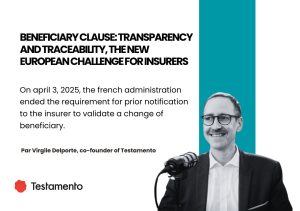On June 12, 2025, Finance Innovation and Testamento brought together several experts from the insurance and protection sectors for a roundtable focused on a topic often viewed as secondary, yet central in impact: the beneficiary clause. Moderated by Anaïs Bréger (Deloitte), the event featured Franck Claisse (Allianz France), Yann Quéré (Lourmel), Éric Marrel (Cegedim Assurances) et Virgile Delporte (Testamento).
A clear issue : Poorly written, outdated, or vague beneficiary clauses can lead to complex situations: untraceable beneficiaries, delayed payouts, legal disputes, and even tax reclaims. In fact, France’s insurance regulatory authority (CCPR) strengthened its requirements in November 2024, urging the entire industry to improve the quality and traceability of beneficiary designations.
An underestimated societal challenge with concrete impact
Speakers highlighted the deep transformation of French society. As Yann Quéré noted, post-WWII families followed a simple model: “the man worked, and the woman and children were the beneficiaries.” That picture has changed drastically:
Reconstituted family
Isolated individuals choosing to leave assets to charities
Beneficiaries outside the traditional family unit
More complex asset and estate structures
At Lourmel, 2/3 of policyholders now draft a custom clause, rather than opting for the default one. The average age is 46, a pivotal time when transmission concerns emerge.
The personalization challenge
Éric Marrel (Cegedim) pointed out the growing expectation gap: while 75% of French people want more personalization, only 18% feel their advisor truly understands their context. This paradox highlights a key challenge: reconciling personalization with operational efficiency.
The beneficiary clause lies at the intersection of three often conflicting domains:
Legal, which demands precision and security
Commercial, which favors simplicity and speed
Human, which requires time for deeply personal decisions
Technology as a pragmatic solution
To address these challenges, technology offers a practical way forward. Virgile Delporte presented the Testamento solution, deployed by major players like Allianz since 2021. The key insight: manually updating clauses had become discouraging for both policyholders and advisors.
The Beneficiary solution includes:
A guided journey for both clients and advisors
Standard or personalized clauses
Automatic generation of legally valid documents
Secure electronic signatures
Full integration into existing business workflows
Successful deployment at Allianz and Lourmel
At Allianz, Franck Claisse recalled a gradual but strategic rollout that began as a POC in 2020 (during the pandemic) and expanded to the 9,000 employees of the internal network. In 2024, the tool was rolled out to general agents. According to Claisse, user feedback has been “extremely positive”, highlighting ease of use and enhanced client interaction.
At Lourmel, Yann Quéré reported similarly smooth adoption. HR teams and employees quickly embraced the tool, improving internal clause management and reducing litigation risks while enhancing data quality for provisioning.
Tangible benefits of mastering the beneficiary clause
Éric Marrel (Cegedim Assurances) outlined several clear advantages:
Security: Updated, well-crafted clauses with full beneficiary identification
Value: Helps HR departments better communicate about protection benefits (often overshadowed by health insurance)
Loyalty: Maintains an ongoing touchpoint with policyholders on otherwise “invisible” contracts
Compliance: Meets tightening regulatory standards
The panel also noted a key trend: corporate tenders increasingly demand digitized beneficiary clause management, turning a technical issue into a competitive advantage.
AI as a decision-support tool rather than an expert replacement
Virgile Delporte addressed the future integration of AI into beneficiary clause management. He emphasized that AI alone cannot solve everything due to risks like misinterpretation or hallucination in sensitive contexts.
Testamento’s approach is a hybrid model:
Reliable algorithms structure guided workflows
AI acts in support: helping advisors, automating compliance checks, and flagging weak signals that may indicate a clause needs updating
A new legal framework: better tools for better security
The discussion referenced a recent ruling by the French Supreme Court (Cour de cassation), confirming the validity of clauses drafted solely by the insured. This legal evolution makes it even more crucial for insurers to provide quality tools to guide and secure clause modifications.
Security features now include:
Automated checks on suspicious age patterns or edits
Full traceability of operations
Level 2 secure electronic signatures
AI-based detection of potential fraud or abuse
Best practices to begin the transformation
For insurers considering this shift, Virgile Delporte recommended:
- Avoid panic—start with an audit of existing clauses
- Roll out in stages with pilot programs
- Use plug-and-play external solutions
- Plan for gradual integration into existing IT systems
The beneficiary clause as a pillar of insurance transformation
Far from being a niche issue, the beneficiary clause is now a core strategic concern for insurers. It directly affects a massive share of the workforce, 87% of employees are covered by group protection plans, and plays a key role in life insurance, France’s most popular savings product.
At the same time, it’s becoming a symbol of brand responsibility and innovation, as clients expect more transparency, personalization, and seamless service.
The digital transformation of this clause, long postponed for technical or budget reasons, has become unavoidable, driven by regulatory pressure, operational performance demands and intensifying competition.




